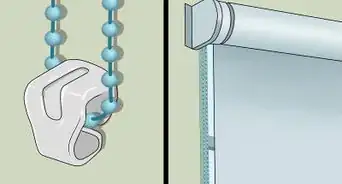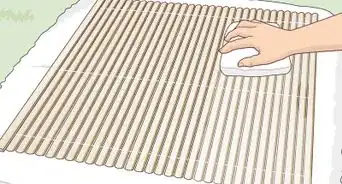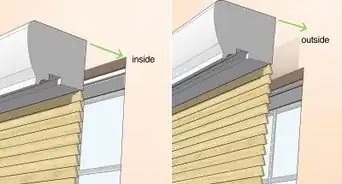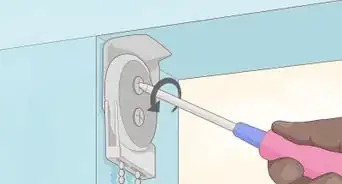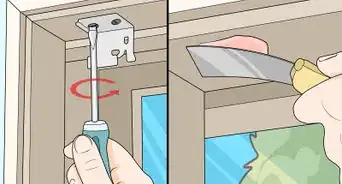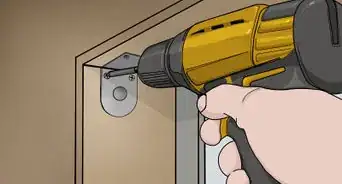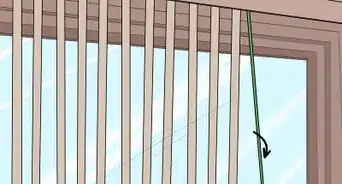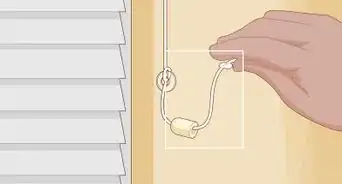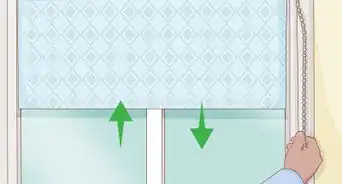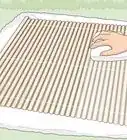X
wikiHow is a “wiki,” similar to Wikipedia, which means that many of our articles are co-written by multiple authors. To create this article, 10 people, some anonymous, worked to edit and improve it over time.
This article has been viewed 100,584 times.
Learn more...
Vertical blinds often used to cover sliding glass doors or large windows. When measuring and ordering vertical blinds, you should decide whether you want them mounted inside the door or window frame, or on brackets outside the frame. Here's how to install vertical blinds using either method.
Steps
Method 1
Method 1 of 3:
Mounting Inside the Window Frame
-
1Screw holes into the valance. The valance is L-shaped so the top surface can be mounted inside the upper frame and the front of the valance will hide the headrail.
- Place the valance on a flat surface with the front of the valance in an upright position.
- Measure 3 inches (7.6 cm) from each end and position each bracket so the top edge is against the upright valance.
- Use a pencil to mark the 2 screw holes in each bracket.
- Predrill the four holes, with a smaller bit than the actual screws you will use for the screws (if possible).
-
2Mark the bracket location on the frame. Mark holes for the brackets on the inside of the upper frame of the door or window.[1]
- Measure 3 inches (7.6 cm) from the side of the frame and 1 inch (2.5 cm) out from the glass.
- Hold the first bracket in place, place a screw in the first hole and tap with a hammer to make a mark. Make another mark in the second hold.
- Repeat on the other side for the second bracket.
Advertisement -
3Attach the components. Attach the valance and brackets to the inside frame.[2]
- Position the valance in the window so the marks you made in the upper frame are visible through the holes you drilled in the valance.
- Have a helper hold the valance while you attach the screws through the bracket and valance.
- Repeat. Repeat on the other side for the second bracket.
-
4Snap in the headrail. Snap the blinds head rail into the brackets by hooking the front end into the clip and then lifting the back end until it clicks into place.
-
5Attach the vanes. If you don't know how, see the section on attaching the vanes later in the article.
Advertisement
Method 2
Method 2 of 3:
Mounting Outside the Window Frame
-
1Locate the headrail. Determine the placement of the blinds' headrail over the window.
- Pick a point under the window, but near the center, where you want the bottom of the blinds to reach.
- From that point, measure the height of the blinds up to the top of the window and make a pencil mark.
-
2Mark the positioning of the brackets. You'll need a helper for this step.[3]
- Have a helper place the headrail directly on the pencil mark, while you check that's it's straight with a level.
- Measure 4 inches (10 cm) from the end of the headrail and make a pencil mark directly over the headrail.
- Repeat on the other end for the second bracket.
- If installing vertical blinds wider than 62 inches (1.5 m), mark the positioning of the additional support brackets provided.
-
3Attach the brackets to the wall with the provided screws. If the brackets are being attached to drywall rather than a wood frame around the window, drill a hole and insert wall anchors first.[4]
-
4Snap in the headrail. Hook the headrail onto the brackets.
-
5Attach the vanes. If you don't know how, follow the instruction in the section on attaching the vanes later in the article.
-
6Install the valance. Add a valance, if you want one and one was included.
- Push the corners onto either end of the front piece of the valance, and then attach the side pieces.
- Snap the provided clips along the headrail.
- Slide the valance into the clips.
Advertisement
Method 3
Method 3 of 3:
Attaching the Vanes
-
1Space the vanes. Pull the cord on the blinds to evenly space the stems that will hold the individual vanes (or louvers).
-
2Rotate the stems. Rotate the stems so you can see the slits.
-
3Attach the vane. Take the first vane and push the end with a hole up into the slit until the hook catches in the hole.[5]
-
4Attach the rest of the vanes to their stems. Using the same technique, attach the remaining vanes, making sure they all face the same direction (if they're curved). Test the stems when you're done.
Advertisement
Community Q&A
-
QuestionWhat would cause the slats on my blinds not to turn?
 Community AnswerIf they are not caught on something on the bottom, it likely is an issue with the top gears.
Community AnswerIf they are not caught on something on the bottom, it likely is an issue with the top gears. -
QuestionThe holes in the wall are too big from previous installation. How do you fix that?
 Community AnswerYou can fill in the holes with spackle and re-drill, or you could try plastic anchors for your screws.
Community AnswerYou can fill in the holes with spackle and re-drill, or you could try plastic anchors for your screws. -
QuestionWhat's the best way to hang vertical blind slats when they are too long?
 Community AnswerEither hang them higher so they don't touch the ground, or trim the ends (which I don't recommend). The best thing to do would be to just buy blind slats that fit correctly.
Community AnswerEither hang them higher so they don't touch the ground, or trim the ends (which I don't recommend). The best thing to do would be to just buy blind slats that fit correctly.
Advertisement
Things You'll Need
- Tape measure
- Pencil
- Cordless drill
- Screwdriver attachment for drill
- Hammer
- Level
- Wall anchors (optional)
- Stepladder
References
- ↑ https://www.levolor.com/how-to-install-vertical-custom/
- ↑ https://www.baliblinds.com/globalassets/3.-documents/installation-instructions/bali-vertical-blinds-installation-instructions-angled-headrail-inside-ceiling-mount.pdf
- ↑ https://www.baliblinds.com/globalassets/3.-documents/installation-instructions/bali-vertical-blinds-installation-instructions-angled-headrail-outside-mount.pdf
- ↑ https://www.baliblinds.com/globalassets/3.-documents/installation-instructions/bali-vertical-blinds-installation-instructions-angled-headrail-outside-mount.pdf
- ↑ https://www.bunnings.com.au/diy-advice/home-improvement/windows/how-to-install-vertical-blinds
About This Article
Advertisement
